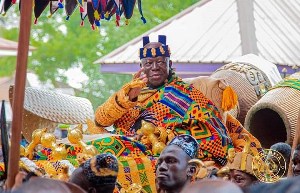Opinions of Saturday, 24 June 2017
Columnist: Albert Adu Boahen
Mfantsipim and the making of Ghana
IF you wanted to buy a copy of this book, you'd have to cough up $487.74 US! Published by Prof Albert Adu Boahen's own Sankofa Educational Publishers in 1996, it's currently out of print and anyone who possesses a copy can make a killing by reselling it to Amazon.Com, Abebooks.Com and other retailers of used books.
But is it worth the near $500 that the sellers are asking for a copy?
It certainly is, but that's not the issue. A book such as this should be readily available to all our educationists, as well as the general reader. That it should cost so much will, of course, put off many of those who need to read it for professional reasons, as well as the general reader.
Unfortunately, that's why I am glad to report that some members of the family of the late Professor have been in touch with one of our most enterprising and efficient publishers, Mr Fred Labi of Digital Books, to bring out potentially a new edition of the book. It will be a service to the country if the deal goes through.
For although Prof Adu Boahen was a historian, the book he wrote about his alma mater is anything but the stodgy historical tome one could expect to come from such a work. Yes, the book is over 500 pages long and is necessarily cluttered in places with the mundane details about the founding and running of Mfantsipim School. However, the beginnings of Mfantsipim and the word "struggle" go together, and the result is that you can't put it down once you start reading it! The reason is that Prof Adu Boahen was a very good story-teller indeed and so handles historical data as if he were spinning a yarn straight of his witty brain.
He achieves this readability by telling the story of Mfantsipim through the plethora of personalities who made the School what it was and is. He recounts the conflicts that faced the founders, as they sought to establish an institution that would be a religious establishment and yet be able to compete with the best educational institutions qua educational institution on their own terms, anywhere in the world.
Money was the most a constant worry of the founders, right from the very beginning. But so enlightened and far-sighted were those interested in making it succeed that no sacrifice was too great to make; no obstacle too insurmountable as to stop them. Renting temporary premises for the students from landlords with different personalities and interests; procuring land to erect new buildings and again, facing landlords interested only in money; what curriculum to teach the students, whether they were in rickety rented premises or their own new buildings – these were dynamic, ever-present problems that had to be solved by both the white missionaries (who only had a few years to make their mark) and their colleagues, the Ghanaian intellectuals whose selfless nationalism propelled them to offer both cash and intellectual succour to an institution which they intelligently foresaw would play a pivotal role in training the people who would run Ghana when as they believed fervently the time came for the nation to govern itself.
Two heroes, above all, stand out, unequalled, in the Mfantsipim story: W.T. Balmer (headmaster of the School from 1907-1910) and the Rev. Alfred Bartop, who became the School's head in October 1903 and recruited the indomitable Balmer to take over from him. It was he who championed Bamer'd cause relentlessly till his death. Others, like the Rev. Alex Smith, later built upon the foundation laid by Barttrop and Balmer and ensured that Mfantsipim became not only the leading educational institution in the Gold Coast, but the whole of West Africa.
(Mfantsipim's leadership in the educational field, by the way, was not bestowed by men but endowed by objective facts – namely, it did better than any other schools in the external examinations in which it entered its students!)
Because he was so interested, in a very personal way, in the story of the School, Adu Boahen uses his skill as a historian and his flair as a storyteller, to relate the School's story, avoiding any tendency to bore readers, long and tortuous though the history of the School is. We share his with excitement as he wonders whether one more crisis in the School's affairs will be one too many.
Then we are made to taste Adu's breadth of knowledge as he tells us, for instance, about the “Sphinx Riddle” and how it was solved at Mfantsipim.
He inspires us by fully exploring the role of the Africans who supported Mfantsipim with money, time and goodwill through thick and thin and thereby ensured that it did not lose sight of African values and concerns while trying to maintain itself as a good Wesleyan/Methodist institution; men such as Casely-Hayford, Mensah Sarbah Ato Ahumah and Kobina Sekyi.
But the book is not only about worthy people. Like all good reads, it contains its share of villainous characters, some of whom were racists who not only fought against the School's progress but regarded its objective of training Africans to become well-educated, responsible human being as an impossibility. Some actually fought hard to prevent the school from being developed by others to attain that ambitious goal that was quite unique on the African continent.
Adu Boahen effortlessly glides through numerous memorable and inspiring stories for instance, that of “The Faithful Eight” [students] who stayed on even when the School had officially been closed down! They later continued to exercise an influence, in sundry ways, to keep it afloat during several of the crises that dogged its very existence.
Now, a good historian brings to life matters which happened before he was born and which is brought to life for him only through the records available, or from the eye-witness accounts of those who took part in those events. So what happens when the historian is himself an eye-witness to a historic occurrence?
Readers of this book will be treated to Adu Boahens scintillating account of how the 1948 arrest of “The Big Six” UGCC leaders affected the students not only of Mantsipim but also of the two other secondary schools in Cape Coast – Adisadel and St Augustine's. Adu's account is extremely valuable, for it shows us that the students of rival schools could unite to take joint action when the issue was of great enough import.
Even more significant, Adu enables us to see that when push came to shove, many of the European teachers in the Gold Coast, despite the loud noises they had been making about the value of the democratic system of government, were imperialist-minded bigots who were sympathetic to the dictates of the colonial administration and saw little wrong in the totalitarian policies of such a silly old clod like the Governor of the Gold Coast at the time, Sir Gerald Creasy (who arrested and "The Big Six" and deported them to Northern Ghana for a period.)
Adu Boahen's book, then, is a very valuable treatise that moves away from the narrow confines of the life and history of Ghana's first secondary school (a worthy enough objective though it is in its own right), but also, of the political life and times of the nation in which the school was founded and flourished. There's a lot more in the book than can be commented upon in this short review, and I urge all those who read this to look out for a new edition and to grab a copy, if and when its publication becomes a reality.













